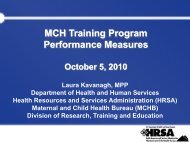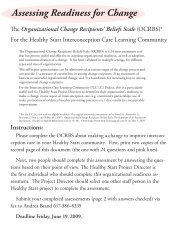Pediatric Case Studies - HRSA
Pediatric Case Studies - HRSA
Pediatric Case Studies - HRSA
Create successful ePaper yourself
Turn your PDF publications into a flip-book with our unique Google optimized e-Paper software.
PEDIATRIC CASE STUDIES: EMERGENCY DEPARTMENT TRIAGE<br />
19. Level 2. High risk situation. The patient is depressed and expressing suicidal<br />
thoughts. She should be considered a danger to herself and should not be left<br />
alone or in the waiting room.<br />
20. Level 1. This child has an altered mental status after a significant, witnessed,<br />
closed head injury. She is also tachycardic and tachypneic and may have<br />
pulmonary contusions or internal bleeding.<br />
21. Level 4: One resource. The laceration will require suturing (a simple procedure).<br />
If the child were younger or uncooperative he might need sedation for the repair<br />
which would make him an ESI 3.<br />
22. Level 2. Although this child appears to be in no distress, we are also triaging the<br />
father in this case. The triage nurse, the child, other patients and staff are at risk<br />
of being harmed by this father. Calling security or an outside police agency may<br />
be a possibility, but it would not be prudent to allow this family to wait in the<br />
waiting area.<br />
23. Level 3: Two or more resources. This child will likely require labs, IV fluids and<br />
diagnostic tests such as ultrasound or CT scan.<br />
24. Level 4: This patient will require one resource (an x-ray). He may need a splint<br />
or crutches, but those are not resources. If his ankle were deformed or an<br />
orthopedic consult is routine for all fracture patients at your institution he would<br />
be a level 3.<br />
25. Level 2: This is a high risk situation. This child had an apparent life threatening<br />
event (ALTE) at home, and while it may have been due to a benign cause (such<br />
as reflux), you need to rule out more serious problems such as sepsis, seizures<br />
or cardiac disease. This infant will need multiple diagnostic tests and admission<br />
to the hospital.<br />
Funded by Grant H34MCO4371 From the Health Resources and Services Administration/<br />
Maternal and Child Health Bureau’s Emergency Medical Services for Children Program.<br />
© 2010 University of North Carolina at Chapel Hill<br />
7




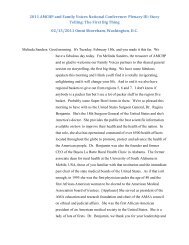



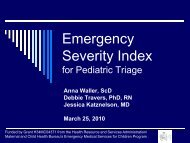
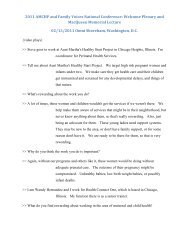
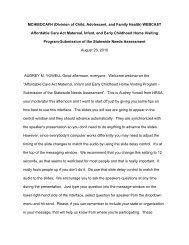
![Hormone Disruptors and Women's Health: Reasons for Concern [PDF]](https://img.yumpu.com/19410002/1/190x245/hormone-disruptors-and-womens-health-reasons-for-concern-pdf.jpg?quality=85)

